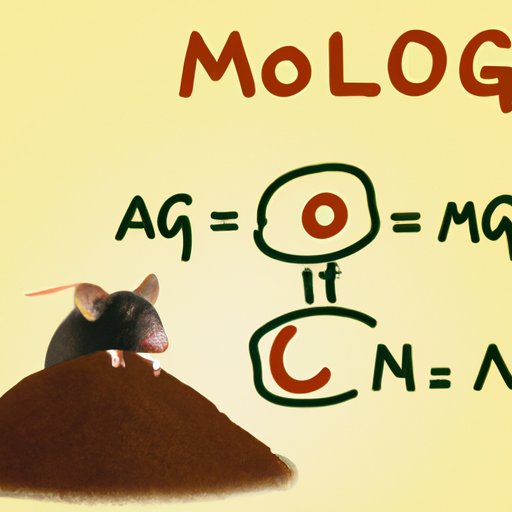Introduction
As a fundamental concept in chemistry, learning how to convert grams to moles is essential. Moles are used to measure the amount of a substance in a chemical reaction, and understanding how to convert between grams and moles is fundamental to solving chemical problems. In this article, we will provide a step-by-step guide on how to convert grams to moles, as well as discuss the history and practical applications of the mole concept.
A Step-by-Step Instructional Article
What is a Mole?
A mole (mol) is a unit of measurement in chemistry that describes an amount of a particular substance. It is a unit of measurement that stands for Avogadro’s number (6.022 x 10^23) of particles of that substance. These particles could be atoms, ions, or molecules.
Why is Converting Between Grams and Moles Important?
When working with chemical reactions, understanding the amount of a substance is crucial. While the mass of a substance can be measured in grams, the true meaning of the amount of the substance in the reaction can only be determined in moles. Thus, converting between grams and moles is essential for understanding the chemical reaction concepts.
The Formula for Converting Grams to Moles
The formula for converting grams to moles is as follows:
N = m/M
Where:
N: the number of moles
m: the mass of the substance in grams
M: the molar mass of the substance in grams per mole
How to Use the Formula with Step-by-Step Instructions
Converting grams to moles involves three steps:
- Find the molar mass of the substance in grams per mole
- Divide the mass of the substance in grams by the molar mass to get the number of moles
- Round off the answer to the appropriate significant figures
Examples of Converting Grams to Moles
Let’s convert 50 grams of sodium chloride (NaCl) to moles using the formula we just discussed:
- Find the molar mass of NaCl: Na (23.0 g/mol) + Cl (35.5 g/mol) = 58.5 g/mol.
- Calculate the number of moles: N = 50 g ÷ 58.5 g/mol = 0.85 mol.
- Rounding off to the appropriate significant figures, we get 0.9 mol of NaCl.
Graphical Representation
How Visual Aids Can Help Readers Better Understand Conversion
Visual aids like flowcharts and diagrams are essential for understanding the mole concept. They simplify the conversion process and make it less overwhelming.
Charts and Graphs to Demonstrate the Process of Converting Grams to Moles
There are two visual aids that can be used to illustrate the conversion process:
A Graphical Flowchart to Show the Formula Process

Using Diagrams to Illustrate the Concept of a Mole

Application-Driven Article
Common Applications for Converting Grams to Moles
The conversion of grams to moles is crucial for chemistry laboratory work. It is essential to know the number of moles of a substance needed to achieve a particular reaction. For instance, in an acid-base titration, the amount of acid or base needed to neutralize a solution is determined by converting the volume of the solution into moles and then using that measurement to calculate the amount of the solution required.
Instructions on How to Convert Grams to Moles for Specific Applications
In laboratory settings, the process of converting grams to moles can be carried out quickly by following the step-by-step instructions provided above.
Q&A-Style Article
Answers to Frequently Asked Questions Regarding Gram-to-Mole Conversion
What is the formula to convert grams to moles?
The formula to convert grams to moles is N = m/M.
How do I use the formula to convert grams to moles?
- Find the molar mass of the substance in grams per mole
- Divide the mass of the substance in grams by the molar mass to get the number of moles
- Round off the answer to the appropriate significant figures
What are common mistakes to avoid?
One of the most common mistakes when converting grams to moles is using the wrong molar mass. Always double-check the molar mass of the substance you’re working with before doing any calculations. Another mistake to avoid is rounding off too soon and not carrying enough significant figures through the problem.
Additional Tips for Accurate Gram-to-Mole Conversion
It’s essential to be precise when measuring the mass of a substance. Using a triple-beam balance or an electronic balance to measure mass ensures precision. Additionally, the student should always double-check the molar mass table they’re using to ensure they select the appropriate number.
Historical Context Article
The History and Development of the Mole Concept
The mole concept was introduced by the Italian scientist Amedeo Avogadro in the early 19th century. After discovering that certain gases would always react in fixed ratios, Avogadro concluded that there must be a fundamental unit of measurement for the number of atoms or molecules in a particular mass – which slowly developed into the mole concept
How the Mole is Defined in the Scientific Community
A mole is defined as the fundamental unit of measurement for the number of atoms, ions, or molecules in a particular mass or substance. One mole is equal to 6.022 x 10^23 individual particles.
A Brief Practical Instruction on Converting Grams to Moles
To convert grams to moles, divide the mass of the substance by the substance’s molar mass.
Conclusion
In conclusion, understanding how to convert grams to moles is essential in chemistry. The step-by-step guide provided in this article can help students understand the conversion process and avoid common mistakes. Additionally, the historical and practical applications of the mole concept have been highlighted, underscoring its importance in chemistry. With this knowledge, chemistry enthusiasts can enhance their understanding and take their laboratory skills to the next level.
